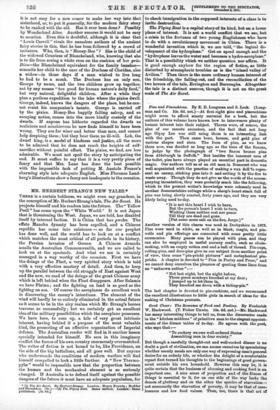Pins and Pincushions. By E. D. Longman and S. Lock.
(Long- man and Co. 10s. 6d. net.)—At first sight pins and pincushions might seem to afford scanty material for a book, but the authors of this volume have known how to interweave plenty of human interest into their subject. Thorns were, of course, the pins of our remote ancestors, and the fact that not long ago Gipsy Lee was still using them is an interesting link with the past. Then came bone, bronze, and gold pins of various shapes and sizes. The form of pins, as we know them now, was decided as long ago as the time of the Saxons, to judge by the photograph of "two Saxon bronze pins from Aldeburgh in Suffolk." But besides the innocent uses of the toilet, pins have always played an essential part in domestic magic. Our authors tell us of an old man in Somerset who was well acquainted with the practice of making a wax doll to repre- sent an enemy, sticking pins into it and setting it by the fire to waste away. Though they do not give us the words of the accom- panying incantation, they were probably much like the following, which to the present writer's knowledge were solemnly used in another Somersetshire cottage while a sheep's heart stuck full of pins was being slowly roasted, forty years ago, and they are very likely being used to-day.
"It is not this heart I wish to burn,
But the person's heart I wish to turn, Wishing them neither rest nor peace Till they are dead and gone.
[Put some more salt on the fire, Jarge.] "
Another version of this charm was used in Derbyshire in 1873. Pins were used in white, as well as in black, magic, and pin- wells and pin offerings are connected with some pretty little ceremonies. Many games can be played with pins, and they can also be employed in useful nursery crafts, such as chain- making, with an empty cotton reel and a ball of thread. Pin-cups, rolling-pins, and door-pins give us our subject from another point of view, then come "pin-prickt pictures" and metaphorical pin- pricks. A chapter is devoted to " Pins in Poetry and Prose," and we cannot deny ourselves the pleasure of quoting these lines from an "unknown author"
"Not last night, but the night before, Three great monkeys knocked at my door ; I jumped up to let them in,
They knocked me down with a tirling-pin."
The last chapter is devoted to pin-cushions, and we recommend the excellent illustrations to little girls in search of ideas for the making of Christmas presents.


































































 Previous page
Previous page